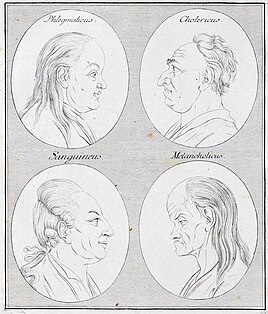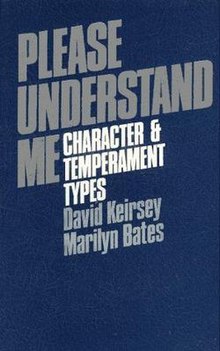
Personality psychology is a branch of psychology that examines personality and its variation among individuals. It aims to show how people are individually different due to psychological forces. Its areas of focus include:
Socionics, in psychology and sociology, is a pseudoscientific theory of information processing and personality types. It is distinguished by its information model of the psyche and a model of interpersonal relations. It incorporates Carl Jung's work on Psychological Types with Antoni Kępiński's theory of information metabolism. Socionics is a modification of Jung's personality type theory that uses eight psychic functions, in contrast to Jung's model, which used only four. These functions are supposed to process information at varying levels of competency and interact with the corresponding function in other individuals, giving rise to predictable reactions and impressions—a theory of intertype relations. In contrast to the generally accepted views in science on age-related variability of the human psyche, socionics postulates the presence of 16 psychological types unchanged throughout life. The issue of the existence of personality types is considered by modern science to be extremely controversial.

In personality typology, the Myers–Briggs Type Indicator (MBTI) is an introspective self-report questionnaire indicating differing psychological preferences in how people perceive the world and make decisions. The test attempts to assign four categories: introversion or extraversion, sensing or intuition, thinking or feeling, judging or perceiving. One letter from each category is taken to produce a four-letter test result, such as "INTJ" or "ESFP".
In psychology, temperament broadly refers to consistent individual differences in behavior that are biologically based and are relatively independent of learning, system of values and attitudes.

The four temperament theory is a proto-psychological theory which suggests that there are four fundamental personality types: sanguine, choleric, melancholic, and phlegmatic. Most formulations include the possibility of mixtures among the types where an individual's personality types overlap and they share two or more temperaments. Greek physician Hippocrates described the four temperaments as part of the ancient medical concept of humourism, that four bodily fluids affect human personality traits and behaviours. Modern medical science does not define a fixed relationship between internal secretions and personality, although some psychological personality type systems use categories similar to the Greek temperaments.

A personality test is a method of assessing human personality constructs. Most personality assessment instruments are in fact introspective self-report questionnaire measures or reports from life records (L-data) such as rating scales. Attempts to construct actual performance tests of personality have been very limited even though Raymond Cattell with his colleague Frank Warburton compiled a list of over 2000 separate objective tests that could be used in constructing objective personality tests. One exception however, was the Objective-Analytic Test Battery, a performance test designed to quantitatively measure 10 factor-analytically discerned personality trait dimensions. A major problem with both L-data and Q-data methods is that because of item transparency, rating scales and self-report questionnaires are highly susceptible to motivational and response distortion ranging all the way from lack of adequate self-insight to downright dissimulation depending on the reason/motivation for the assessment being undertaken.
The Keirsey Temperament Sorter (KTS) is a self-assessed personality questionnaire designed to help people better understand themselves and others. It was first introduced in the book Please Understand Me. It is one of the most widely used personality assessments in the world. The KTS is closely associated with the Myers–Briggs Type Indicator (MBTI); however, there are significant practical and theoretical differences between the two personality questionnaires and their associated different descriptions. It has been criticized as pseudoscience.
Cognitive functions, also referred to as psychological functions, as described by Carl Jung in his book Psychological Types, are particular mental processes within a person's psyche that are present regardless of common circumstance. This is a concept that serves as one of the foundations for his theory on personality type. In his book, he noted four main psychological functions: thinking, feeling, sensation, and intuition. He introduced them with having either an internally focused (introverted) or externally focused (extraverted) tendency which he called "attitudes".

David West Keirsey was an American psychologist, a professor emeritus at California State University, Fullerton, and the author of several books. In his most popular publications, Please Understand Me and the revised and expanded second volume Please Understand Me II (1998), he laid out a self-assessed personality questionnaire, known as the Keirsey Temperament Sorter, which links human behavioral patterns to four temperaments and sixteen character types. Both volumes of Please Understand Me contain the questionnaire for type evaluation with detailed portraits and a systematic treatment of descriptions of temperament traits and personality characteristics. With a focus on conflict management and cooperation, Keirsey specialized in family and partnership counseling and the coaching of children and adults.

Isabel Briggs Myers was an American writer and co-creator with her mother, Katharine Cook Briggs, of a personality inventory known as the Myers–Briggs Type Indicator (MBTI) and based on theories of Carl Jung.
John Beebe is an American psychiatrist and Jungian analyst in practice in San Francisco.

Katharine Cook Briggs was an American writer who was the co-creator, with her daughter Isabel Briggs Myers, of an inventory of personality type known as the Myers–Briggs Type Indicator (MBTI).
In psychology, personality type refers to the psychological classification of different types of individuals. Personality types are sometimes distinguished from personality traits, with the latter embodying a smaller grouping of behavioral tendencies. Types are sometimes said to involve qualitative differences between people, whereas traits might be construed as quantitative differences. According to type theories, for example, introverts and extraverts are two fundamentally different categories of people. According to trait theories, introversion and extraversion are part of a continuous dimension, with many people in the middle. In contrast to personality traits, the existence of personality types remains extremely controversial.

Psychological Types is a book by Carl Jung that was originally published in German by Rascher Verlag in 1921, and translated into English in 1923, becoming volume 6 of The Collected Works of C. G. Jung.
Gifts Differing: Understanding Personality Type is a 1980 book written by Isabel Briggs Myers with Peter B. Myers, which describes the insights into the psychological type model originally developed by C. G. Jung as adapted and embodied in the Myers–Briggs Type Indicator (MBTI) personality test. The book explains the many practical applications of this typological model using four categories of psychological type differences - Extraversion / Introversion; Sensing / Intuition; Thinking / Feeling; Judging / Perceiving. The book also suggests how different combinations of these characteristics tend to influence the ways people perceive the world and how they both respond to and interact with it. Type tables show how type preferences tend to correlate with occupational interests. Profiles of the sixteen types also suggest how people of each type tend to act and relate to people with other type dynamics.
The two-factor model of personality is a widely used psychological factor analysis measurement of personality, behavior and temperament. It most often consists of a matrix measuring the factor of introversion and extroversion with some form of people versus task orientation.
The Jungian Type Index (JTI) is an alternative to the Myers–Briggs Type Indicator (MBTI). Introduced by Optimas in 2001, the JTI was developed over a 10-year period in Norway by psychologists Thor Ødegård and Hallvard E: Ringstad. The JTI was designed to help capture individuals' preferred usage of the psychological functions identified by Carl Jung in his book Psychological Types, such as thinking vs feeling and sensing vs intuition.
Interpersonal compatibility or interpersonal matching is the long-term interaction between two or more individuals in terms of the ease and comfort of communication.

Psychological typologies are classifications used by psychologists to describe the distinctions between people. The problem of finding the essential basis for the classification of psychological types—that is, the basis of determining a broader spectrum of derivative characteristics—is crucial in differential psychology.
True Colors is a personality profiling system created by Don Lowry in 1978. It was originally created to categorize at risk youth into four basic learning styles using the colors blue, orange, gold and green to identify the strengths and challenges of these core personality types.






